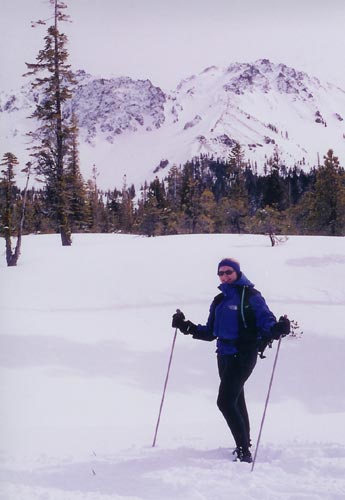The groundhog saw his shadow this year
"Six more weeks of winter," my husband, Kip says. I look out the window at tulips whose green heads poke from the warm dirt of my garden.
"I don't believe in that kind of stuff," I say and go back to reading my book.
The next morning I wake to fresh snow blanketing the dark pines. Sunlight shafts between trees in a blue sky studded with gray clouds. Occasional gusts of a brisk wind swirls ice crystals across the backyard. My tulips are nowhere to be seen.
"Let's go skiing at Lassen," Kip suggests.
Lassen Volcanic National Park lies just a short drive east of our home in Shingletown, California. Established in 1916 it encompasses over 106,000 acres, spans three counties and has 150 miles of trails, seventeen of which include the Pacific Crest Trail. Lassen's jagged 10,457 foot peak remains covered in ice and snow for a good portion of the year. The park's geography boasts many pristine lakes and burbling streams, as well as volcanic mud pots and steam vents. Best of all it is largely undiscovered. Lassen gets as many visitors annually as Yellowstone draws in one day.
Kip and I don warm clothes and load our cross country skis and boots in the car. The drive to Lassen Park takes us less than 20 minutes. We pull into the parking area, one of five cars on a beautiful Sunday morning in late February. The Manzanita Lake entrance gives visitors several choices of routes for cross country skiing and snowshoeing. We are encouraged to register our names, destination, and time we expect to return before heading out to the back country. Next to the registry, someone has posted cautionary advice about being prepared for sudden changes in weather.
I look at the turquoise sky and note dark clouds building in the distance.
"Let's stay on the road today," I suggest to Kip.
In winter, most of the Park's roads are closed to vehicles. At Manzanita Lake, the snow-covered pavement beginning at the Ranger Station is a perfect "trail" on which to ski. We clip on our boards and move out, ascending east through towering pines and cedars. The squeak of our ski bindings and Kip's and my steady breathing break the silence of the wilderness. The air is chilly, but before long I am sweating beneath my jacket. The first part of the trail climbs steadily for nearly a mile. I am out of breath by the time we exit the woods and enter the Devastated Area.
The Devastated Area of Lassen Park speaks to the force of nature. In May 1915 Lassen Peak erupted, sending a mushroom cloud of ash seven miles into the stratosphere. Moving at 100 mph, the ash rocketed down the peak's Northeast side and flattened its dense forests. The result is thousands of volcanic rocks piled haphazardly across a landscape of new tree growth. I look south and admire Lassen Peak. It soars into the February sky, a white triangle wreathed in storm clouds. Mare's tails wisp from its sides. The ground stretches out toward this sight unblemished except for the cross hatched pattern of a bird's feet whose hollow bones make it possible to dance along the powdery surface.
"Listen," I whisper. Behind us, silence is broken only by the wind catching in the pines; the sound very close to that of the ocean inside a seashell.
We resume our trek, a level stretch which allows tired muscles to rest. Ahead of us a lone skier approaches; head tucked low against the cold; arms stabbing forward and back; stride fluid. He wears a heavy woolen sweater and traditional wool ski knickers. We step off the trail to let him pass unhindered, but instead he stops to talk. I am surprised to see this is not a young man.
"Gorgeous day," he says. "But, storm's coming." He gestures over his shoulder with a hooked thumb.
"Do you ski here a lot?" Kip asks. The man nods. "Every winter. And it's been a lot of winters. I'm 78 years old." He grins, seems to enjoy our surprised reaction upon learning his age. "How far are you going?"
"Not much farther," I say.
"Have fun," he says before gliding away with the grace of a dancer.
We continue east toward a darkening horizon of gunmetal clouds. The wind picks up and whips ground snow against our jackets. The air temperature drops. Time to head back.
We reverse our course. The clouds chase us. We pole hard past the Devastated area trying to outrace the blizzard. But as we descend into the woods the storm catches up, whitening the sky and stinging our cheeks. The wind no longer whispers through the pines; now it rips through our clothes and throws ice from the trees. When we finally reach the parking area, we are grateful to climb inside our car and turn on the heater.

Later, at home again, we sit near the woodstove while outside winter's fury batters the house. The rafters creak. The wind blows music down the chimney. Deep in his burrow the groundhog sleeps.
Six more weeks of winter. I have become a believer.

The Piker Press moderates all comments.
Click here for the commenting policy.